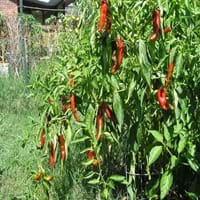Life Span
Perennial
Perennial
Origin
North America, United States, Northeastern United States, Mid-Atlantic United States, Southeastern United States, North-Central United States, South-Central United States, Texas
Mexico, Central America, South America
Types
not available
Poblano, Thai pepper, Cayenne pepper
Number of Varieties
Not Available
Habitat
Boggy areas, Fens, Fields, meadows, Swamps, Woodlands
Cultivated Beds
USDA Hardiness Zone
4-9
10-11
Sunset Zone
1a, 1b, 2a, 2b, 3a, 3b, 4, 5, 6, 7
A1, A2, A3, H1, H2, 1a, 1b, 2a, 2b, 3a, 3b, 4, 5, 6, 7, 8, 9, 10, 11, 12, 13, 14, 15, 16, 17, 18, 19, 20, 21, 22, 23, 24
Habit
Thicket/Colonizing
Oval or Rounded
Flower Color
Not Available
White
Flower Color Modifier
Not Available
Bicolor
Fruit Color
Red
Red, Green, Crimson
Leaf Color in Spring
Not Available
Pale Green
Leaf Color in Summer
Not Available
Green
Leaf Color in Fall
Not Available
Green, Black
Leaf Color in Winter
Not Available
Green
Leaf Shape
Oblovate
Cordate
Plant Season
Spring, Fall, Winter
Spring, Summer, Fall
Sunlight
Full Sun, Partial Sun
Full Sun
Type of Soil
Clay, Loam
Loam
The pH of Soil
Acidic, Neutral, Alkaline
Neutral
Soil Drainage
Average
Well drained
Bloom Time
Late Spring
Indeterminate
Tolerances
Not Available
Drought
Where to Plant?
Ground, Pot
Container, Ground, Pot
How to Plant?
Divison, Seedlings
Seedlings
Plant Maintenance
Medium
Medium
Watering Requirements
Keep the ground moist but not water-logged
Requires regular watering
In Summer
Lots of watering
Lots of watering
In Spring
Moderate
Moderate
In Winter
Average Water
Average Water
Soil pH
Acidic, Neutral, Alkaline
Neutral
Soil Type
Clay, Loam
Loam
Soil Drainage Capacity
Average
Well drained
Sun Exposure
Full Sun, Partial Sun
Full Sun
Pruning
Prune after flowering, Prune in early spring, Remove damaged leaves, Remove dead branches, Remove dead leaves
Remove damaged leaves, Remove dead branches, Remove dead leaves
Fertilizers
All-Purpose Liquid Fertilizer, Compost, Fertilize every year, Mulch, Nitrogen
Balanced organic fertilizer
Pests and Diseases
Aphids, Apple Maggot, Fall Webworm, Red blotch, Scale
Anthracnose, Aphids, Bacterial leaf spot, Bacterial soft rot
Plant Tolerance
Not Available
Drought
Flowers
Showy
Insignificant
Flower Petal Number
Not Available
Single
Foliage Texture
Not Available
Medium
Foliage Sheen
Not Available
Glossy
Attracts
Birds
Beetles, Bugs, Insects
Allergy
Not Available
Rash, Swelling
Aesthetic Uses
Showy Purposes
Not Used For Aesthetic Purpose
Beauty Benefits
Not Available
Not Available
Environmental Uses
Air purification
Air purification
Medicinal Uses
Not Available
Antidiarrhoeal, Antiemetic, Antirheumatic, Antispasmodic, Appetizer, Digestive
Part of Plant Used
Fruits
Flowers, Fruits, Leaves
Other Uses
Used As Food, Used as Ornamental plant
Used as a potherb, Used as colouring in foods, Used in curries, soups, stews
Used As Indoor Plant
No
Yes
Used As Outdoor Plant
Yes
Yes
Garden Design
Cutflower, Mixed Border, Screening, Wind Break
Container, Edible, Herb / Vegetable, Tropical
Botanical Name
ARONIA arbutifolia
CAPSICUM annuum 'Boldog Hungarian Spice'
Common Name
Red Chokeberry
Boldog Hungarian Spice Pepper, Paprika Pepper
In Hindi
लाल Chokeberry
Paprika Pepper
In German
Rote Apfelbeere
Paprika -Pfeffer
In French
Red Chokeberry
Paprika Pepper
In Spanish
rojo Chokeberry
Pimentón pimienta
In Greek
κόκκινο Chokeberry
πάπρικα πιπέρι
In Portuguese
Red Chokeberry
Paprika pimenta
In Polish
Red aronii
Papryka Papryka
In Latin
arbutifolia
Paprika Pepper
Phylum
Magnoliophyta
Magnoliophyta
Class
Magnoliopsida
Magnoliopsida
Family
Rosaceae
Solanaceae
Clade
Angiosperms, Eudicots, Rosids
Asterids, Eudicots
Tribe
Not Available
Capsiceae
Subfamily
Not Available
Solanoideae
Number of Species
Not Available
Not Available
Importance of Red Chokeberry and Paprika Pepper
Want to have the most appropriate plant for your garden? You might want to know the importance of Red Chokeberry and Paprika Pepper. Basically, these two plants vary in many aspects. Compare Red Chokeberry and Paprika Pepper as they differ in many characteristics such as their life, care, benefits, facts, etc. Every gardener must at least have the slightest clue about the plants he wants to plant in his garden. Compare their benefits, which differ in many ways like facts and uses. The medicinal use of Red Chokeberry is Not Available whereas of Paprika Pepper is Antidiarrhoeal, Antiemetic, Antirheumatic, Antispasmodic, Appetizer and Digestive. Red Chokeberry has beauty benefits as follows: Not Available while Paprika Pepper has beauty benefits as follows: Not Available.
Compare Facts of Red Chokeberry vs Paprika Pepper
How to choose the best garden plant for your garden depending upon its facts? Here garden plant comparison will help you to solve this query. Compare the facts of Red Chokeberry vs Paprika Pepper and know which one to choose. As garden plants have benefits and other uses, allergy is also a major drawback of plants for some people. Allergic reactions of Red Chokeberry are Not Available whereas of Paprika Pepper have Rash and Swelling respectively. Having a fruit bearing plant in your garden can be a plus point of your garden. Red Chokeberry has showy fruits and Paprika Pepper has showy fruits. Also Red Chokeberry is not flowering and Paprika Pepper is not flowering . You can compare Red Chokeberry and Paprika Pepper facts and facts of other plants too.





